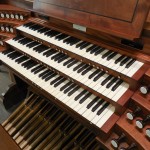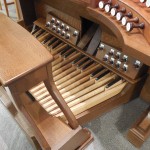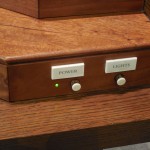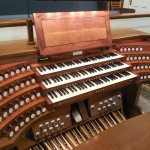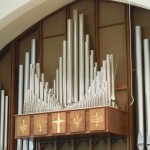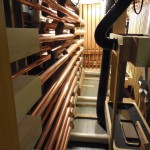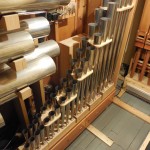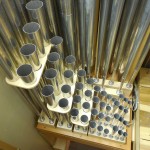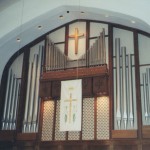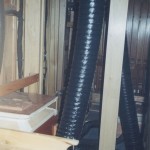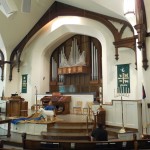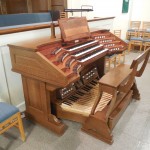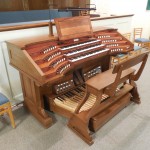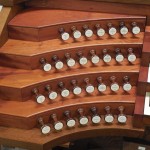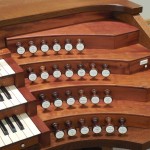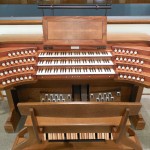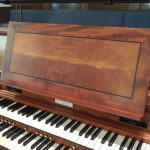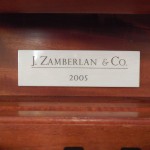Opus 2 began with a phone call asking if I “would be interested in looking at a rebuild?” The caller, Charles Huddleston Heaton, was a schoolmate of Art Carkeek and had just recently played our Opus 1 in Indiana; at the time, Charles was the interim organist at Oakmont Presbyterian Church in Oakmont, Pennsylvania. When I went to inspect the organ and meet with the associate pastor and Charles, I found an instrument that was a decent, if not exemplary, example of “factory” work — being a 1991 M.P. Moller, it was produced at the very end of that firm’s history.
The organ is located in a rather large chamber across the front of the sanctuary; as one faces the front, the Swell is in the left half, and the Great was in the right half. A small chest cantilevered in front of the chamber grille held the Choralbass 4’ extension of the Pedal Principal 16’/8’; this chest had a very noticeable droop, which was a cause of concern to the church — and even more so to the choir members who sang directly beneath it! Even though the blower is located in the basement below the chamber (with a static reservoir), access in the bottom part of the organ was extremely tight due to various flexible conductors used as windlines snaking throughout the space. The location of the Swell chest within the box also made for very difficult access for tuning. A number of pipes already exhibited sagging languids and other mechanical issues.
Most of the existing Moller pipework was retained, as was the electronic 32’ stop, which the church had repaired on its own between the time of my initial visit and subsequent contract negotiations. The Swell chest was moved several inches forward, making tuning within that division much easier. A new Great division is securely cantilevered out over the choir, giving it the most advantageous location from which to lead congregational song. All pipes in the Great are new with the exception of the Mixture III-IV, which was re-pitched to be lower and less shrill than in the previous instrument. The new skirt incorporates bas-relief panels from the old organ as well. A new Great Trompette 8’, based upon classic French models, has no trouble making its presence known, even though it is actually located just behind the façade.
The “new” Positive division is in reality the old Great division. Both the Diapason 8’ and Octave 4’ showed signs of structural problems, such as collapsing languids, after only a dozen years, plus they were too closely placed together on the windchest. We installed the new Viola 8’ and Prestant 4’ in their place; not only do these serve as a lighter foil to the new Great chorus, but now the pipes have sufficient space in which to speak properly. A new Scharff III was installed in the toeboard where the Great Mixture had been; it serves to crown the diapason chorus of the Great, but is still light enough to be used in large choral pieces without overwhelming the singers.
In the Pedal, a new Bombarde unit (Bombarde 16’, Trompette 8’ and Clairon 4’) provides a solid underpinning to the full organ, as well as offering solo cantus possibilities lacking in the former instrument. Although it was not part of the original proposal, we essentially remade most of the wind system; this not only gave us the space to install the Bombarde, but also resulted in much better accessibility in the lower level of the organ chamber.
All of these tonal resources are controlled from a new three-manual console. Its curved, terraced stop jambs, inspired by the designs of German builder Hans Gerd Klais, place a large number of stops within convenient reach of the organist, while also giving the console a lower overall profile. The console shell is constructed of quartersawn white oak, while the interior is made of Honduras mahogany.
GREAT (Manual II, C1-c61)
Bourdon 16’ (PO)
Diapason 8’
Bourdon 8’
Viola 8’ (PO)
Gemshorn 8’ (SW)
Octave 4’
Fifteenth 2’
Mixture III-IV 11⁄3’ *
Trompette 8’
Cymbelstern
Chimes
SWELL (Manual III, C1-c61, enclosed)
Rohrflote 8’ *
Gemshorn 8’ *
Gemshorn Celeste 8’ (from c13) *
Spitzprincipal 4’ *
Rohrflote 4’ (ext.) *
Gemshorn Celeste 4’ (ext.) *
Spitzoctave 2’ (ext.) *
Quinte 11⁄3’ (ext.) *
Contre Trompette 16’ *
Petite Trompette 8’ (ext.) *
Clarion 4’ (ext.) *
Tremulant
POSITIVE (Manual I, C1-c61)
Bourdon 16’ *
Viola 8’
Gedackt 8’ *
Prestant 4’
Gedackt 4’ (ext.) *
Gedackt 2’ (ext.) *
Sesquialtera II 22⁄3’ *
Scharff III 1’
Trompette 8’ (GR)
Schalmei 8’ *
Tremulant
PEDAL (C1-g32, AGO)
Principal 16’ *
Bourdon 16’ (PO)
Octave 8’ (ext.) *
Gedackt 8’ (PO)
Rohrflote 8’ (SW)
Choralbass 4’ (ext.) *
Gedackt 4’ (PO)
Bassoon 32’ (elec.) *
Bombarde 16’
Contre Trompette 16’ (SW)
Trompette 8’ (ext.)
Clairon 4’ (ext.)
* 1991 M.P. Moller
Great/Positive manual transfer with indicator light
